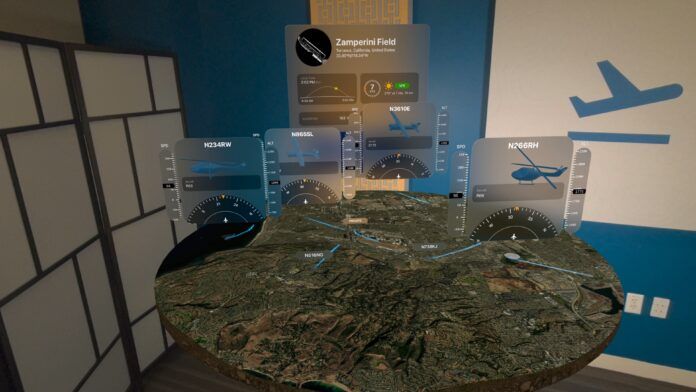ForeFlight announced today (Feb. 1) it has designed Voyager, an advanced 3D airport application developed exclusively for Apple’s $3,499 Vision Pro virtual reality goggle platform. Targeting what ForeFlight refers to as aviation enthusiasts, Voyager “combines satellite imagery, high-resolution terrain and live traffic data to bring each airport to life in 3D on top of a floating disk that users can view from any angle.”
Company CEO Tim Schuetze said, “ForeFlight is excited to deliver this unique 3D airport exploration experience to aviation enthusiasts with Apple Vision Pro. This exciting new spatial computing platform enables us to deliver all-new experiences that were never before possible, and the new Voyager app is a great example of our continued innovation.”
While Vision Pro is priced $3,000 higher than established virtual reality goggle competitor Quest 3, it offers significantly higher resolution for its imaging. Initially targeting professional applications as well as recreational markets, Vision Pro also has high-resolution outward-looking cameras that can present a real-time, real-world view of the environment surrounding the user. That view can be combined with the selected image in a hybrid display of the game or other environment.
ForeFlight’s Voyager application includes connectivity with live traffic feeds for selected airports, enabling “aviation enthusiasts” to view actual real-time aircraft, their altitudes and heading information along with high-resolution images of the airport environment and surrounding terrain. Could reference to ForeFlight’s “continued innovation” suggest the possibility that today’s virtual “floating disks” might someday be replaced by in-flight advanced “head-up” capabilities in low visibility?
Asked to comment on the possibilities of in-flight applications of the Voyager technology, a ForeFlight spokesperson responded, “We’re excited about the potential future applications of the Vision Pro but can only speak to the app our team has created. While ForeFlight Mobile is designed to be used for preflight planning and inflight situational awareness, Voyager was created for aviation enthusiasts to immerse themselves in aviation in a fun and exciting new way.”



































Might help Apple sell Vision Pro!
I had to look up what an Apple Vision Pro was as the whole article wasn’t making sense.
Intriguing. Reviews of the headset appear to be positive but initially I didn’t see much utility for me personally especially at that price point.
This opens up a possible use as I fly out of a very busy uncontrolled airport with a ton of student pilots. While ADS-B as well as keeping my head on a swivel works this might offer even greater situation awareness.
Cost of $3,000-$3,500 along with the inevitable ForeFlight $ upsell versus a mid-air kinda makes it worth at least exploring using this.
Interesting tech, I don’t see the value even in a high traffic area, I can argue it would be a distraction when you should be looking outside. Target fixation and LOC would come to mind.
Not sure this is a good idea. Pilots are already distracted by all the technology in the cockpit and wearing this thing on your head would seem like a massive distraction. It might display ADS-B traffic but what about that big flock of birds while climbing out?
We already have traffic and synthetic vision on the panel / tablet and can get audio traffic and other alerts from ForeFlight. More heads up situational awareness wouldn’t hurt anything.
Or you could just look out the window and see the traffic with your own eyes
Got my Vision Pro on Friday and this app is a real standout among the early crop of apps made for it.
It’s definitely not something you’d use in flight, but it’s a very cool way to visualize an airport’s immediate environment. If you like to check out the ForeFlight 3D view of an unfamiliar airport before flying there, this is like that on steroids.
What I hope they will add is airspace depiction, and the ability to view a larger geographic area. For example, if you look at KJAC, you don’t see the Tetons because they fall outside the radius that it renders.
If you could view the entire SF Bay Area, or LA Basin, or NY Metro area, with all of the airports and airspace depictions, it would be absolutely amazing for really understanding that complex airspace.
PS: the fusion of the virtual environment with your real room environment is incredibly good. The possibilities for flight simulation with a set of physical aircraft controls and physical buttons and switches, combined with virtual instruments, virtual cockpit, and virtual view out the window could be absolutely game-changing.